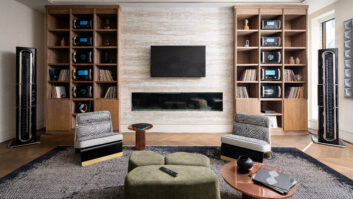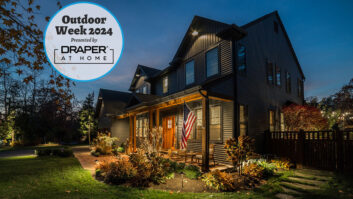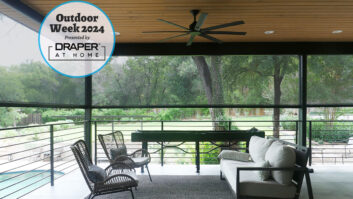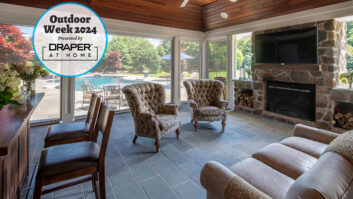Whole-house audio has been one of the bright spots in consumer electronics product sales in recent years. The Consumer Electronics Association projected the multi-room audio-video category to reach $135 million last year and do at least that much again in 2011. Furthermore, according to the CEA’s just-issued 8th Annual State of the Builder Market Technology Study, nationwide builders say that multi-room audio systems provide the biggest boost to profits.

Traditional wired multi-room audio systems like this Crestron installation can support more zones than ever and offer more control over a larger number of content sources.
Traditional wired multi-room audio systems can support more zones than ever and offer more control over a larger number of content sources. However, wireless systems have become very competitive as well, creating an increasingly robust consumer channel that may or may not threaten the exclusive domain of the CEDIA channel. Fortunately for electronic systems contractors, even the most popular wireless systems still require speakers (often in-wall) and even a little wire pulling, enabling ESCs to maintain a foothold in the category.
Wireless for Sound
Jeff Kussard, strategic development director at product distributor Capitol and a 20-plus-year veteran wire-puller himself, said that while the CEDIA channel may have once shied away from “no-wire” solutions, that is no longer the case as the technology has gotten better and the market has shifted. “Not only have wireless whole-house audio products improved in quality and affordability, but the new-home construction business that drove so much wiring work through the mid-decade has evaporated along with housing values.”
But, as Kussard pointed out, that’s where the opportunity lies. Before the recession hit, he explained, new construction never exceeded five percent of the total number of homes in the U.S., and the high point of market penetration for electronic systems contractors was about 20 percent in 2007. That means that the entire CEDIA community has been making its living off of one percent of the number of houses in the country. “Wireless wholehouse audio systems are the perfect product with which to go after the other 95 percent of existing homes that can be retrofitted,” Kussard said.
The math is compelling, as is Kussard’s contention that plug-and-play isn’t always as simple as it’s often touted to be. “Home networking is presented as being plug-and-play, but if that was true, then [Best Buy’s] Geek Squad would be obsolete,” he noted.
Kostas Reissis, director of U.S. sales for wireless whole-house audio systems maker Sonos, says an aversion to wireless solutions is an understandable reaction on the part of many ESCs, and that the panopoly of wireless devices, from iPhone to iPads and a proliferating host of other tablets that are increasingly used to control home systems, will make wirelessness an inevitability for virtually all home systems. Systems like those made by Sonos, which uses the 802.11 G and N wireless protocols (and for which there is an iPad app for remote control), still require wiring skills to link speakers from each room or to a zone’s wireless access point, as well as for in-wall and in-ceiling speaker installation. “The customer benefits from the value the integrator brings to giving the system a clean looking finished installation,” Reissis said.
However, Sonos and other whole-house audio systems makers are addressing both the CE and integration sales and distribution channels. Reissis lists the Sonos ZP120 system as the one best suited for professional installation and its smaller but still scalable S5 system as the flagship CE product. But, Reissis stressed, neither system is exclusive to a particular channel. “The homeowner can certainly purchase and set up the system and still have an integrator in to connect and install in-wall and onceiling speakers,” he said. “The two channels can complement each other.”
Only as Good as the Speakers
Capitol’s Kussard believes that a whole-house audio system is still only as good as its speakers and that in-wall speakers present specific challenges. “In-wall speakers are very often used in whole-house audio systems, and there is a lack of understanding on how to properly optimize in-wall speakers,” he said.
Kussard, who said that he installed the first residential THX system in the U.S., finds that choosing consistent types of speakers room to room is usually as far as many ESCs go. What they tend to overlook, he believes, is the environment in which those in-wall speakers are installed. In a typical installation, with eight-foot ceilings and standardspaced 2×4 wall studs, the size of the speaker cavity is about three cubic feet, he estimated. But if there’s a firestop or some other obstruction in one section of wall that one of the speakers is going into but not in another, you’ll have inconsistently sized cavities, which is going to affect low-frequency and midrange tonality. Kussard said fire-stops or other obstructions reduces the amount of actual airspace in one enclosure relative to the second, which will cause tonality differences between the two speakers.

Travis Deatherage, owner of Solstice Multimedia in Denver, noted that the number of sources in a multi-room audio is growing dramatically in recent years, as evidenced by this control panel from one of his company’s installations.
“The way to rectify that in the cavity for the mated speaker is to implement additional framing in the larger wall cavity to create equal air volumes in both enclosures,” he explained. “This cannot be done reliably via use of damping material. Plus, both cavities should have damping material applied [to address] a different challenge: damping material mitigates air movement within the cavity, which helps to reduce audible effects of air movement such as transference of air movement energy into resonance of wall sections or actual air-rushing noise as it moves through the cavity or into adjacent cavities.”
Another way to optimize whole-house audio in-wall speaker systems in new construction is to use both wood screws and adhesive to bind the sheetrock to the studs, reducing resonance from the wallboard induced by the speaker behind the wall. “You want to make it as rigid as possible,” he said. “If you can control resonance and air volume [behind the wall], you’ve gone a long way to optimizing the speaker part of whole-house audio.”
New Sources, New Challenges
The increasing number of sources offered for a consumer’s listening pleasure, offers its own challenges and opportunities for ESCs looking to maintain their hold on multi-room audio systems integration. While four- to six-source inputs were typical on whole-house audio systems only a few years ago, the necessary number today is closer to 10, noted Travis Deatherage, owner of Solstice Multimedia in Denver. “The number of sources is growing dramatically, and every year there are more, especially when you realize that many whole-house audio systems are paired with wholehouse video distribution, as well,” he said. “The audio system has to be able to handle the video’s audio as well as the growing number of audio-only sources.”
Source can now include internet radio stations, satellite radio, and streaming options including Pandora, Rhapsody, and Mog, as well as gaming stations and personal media devices. In fact, the greater the number of inputs, the better futureproofed the system can be. The sources have become prolific to the point where an ESC like Deatherage now builds systems in which each member of the household is assigned a cable box, rather than assigning one to one or more rooms, then having the audio follow that person’s choice of video throughout the house via the whole-house audio system. Needless to say, this is not as easily handled by a wireless solution. “There is not a reliable, affordable way to move HD video signals wirelessly, and wired audio still provides the best quality and reliability,” he said. “So since the video needs wire, it makes sense that the whole-house audio system is also wired.”
As the number of sources and zones in wholehouse audio installations has grown, so have variations of quality and average volume level between sources, particularly between personal media devices like iPods and Zunes. Larry Weiss president of Newport Beach, CA-based Monaco Entertainment Solutions says there will be significant variation in volume levels between sources like XM satellite radio and an iPod. He says he uses an SPL meter to check the source with the lowest average volume level, then adjusts the others from that. “If you start with the source that has the highest gain level, you’ll have to bring the other sources up to that level, and you could be introducing distortion in the process,” he explained. Another solution is to incorporate a distribution amplifier and a variable gain control for inputs such as iPod docks.
Deatherage seconds that. “The devices with the lower quality audio file formats on them generally tend to have lower average volumes than devices with .wav or other formats,” he explained. “What you want to do is lower the levels of the loudest sources to match those of the [quieter] sources at the input points, then use a volume control for the entire room as the master.” Whole-house systems generally do not offer equalization for the system as a whole, but they can at the room or zone level. Deatherage recommends determining which household members are the primary users of various rooms in the house and then tailor the room EQ curves to those users’ types of audio. “For instance, if there’s a room that’s going to be used for critical listening, we’d optimally calibrate that room’s source for that type of environment,” he said.
Speaking of critical listening, there are still audiophiles out there who want to hear their music in 5.1 surround (and specialty record labels like AIX and Silverline that are still releasing new music titles on Sony’s remarkable but tractionless SACD format). For those clients that want an SACD player as a whole-house system source, Weiss recommends using two players: one that is available as a source for the whole-house system and one that is dedicated to a surround-equipped room in the home. The former needs to be adjusted to fold down to stereo operation. “Otherwise, as you move from a room with surround speakers, like the home theater, to the kitchen or another room that has stereo speakers, you’ll lose several of the [discrete] channels,” Weiss said. “You don’t see it that much anymore, but there are still people out there who want SACD.”
Unlike many other AV technologies, wholehouse audio is not so much more than the sum of its parts as it is defined by the limitations of those parts. “At the end of the day,” said Rick Kukulies, CTO at whole-house audio systems maker NuVo Technologies, “the biggest constraint is the source, and there are more and more sources of various quality to contend with.” However, while streaming media, whole-house audio’s putative weakest link, is also its fastest-growing source of content, it’s also the one that seems to be improving at the quickest rate. Paid premium versions of some audio streaming propositions, like Rhapsody, offer higher transfer rates than their free iterations, and even Apple has increased the number of 256-kb download files available (at a higher cost, too). The notion of lossless streaming could become a mainstream phenomenon in the near future.
Thus, the quality of whole-house audio’s content side is on the road to matching its diversity. And with a growing array of wired and wireless systems on the market, the choices have never been better for consumers and integrators.
CEA and CEDIA Announce Multi-Room Audio Cabling Standard
Last December, the joint CEDIA /CEA R10 Residential Systems committee approved a revised CEA /CEDIA -2030-A: Multi-Room Audio Cabling Standard, which provides documentation for multi-room audio installers, including client labeling and considerations for multiple systems, multiple buildings, grounding and ground loops, and power feeds. The updated standard covers more material, providing sample documentation and diagrams of multi-room audio systems.
“Of all the cross-industry best practices, this is the one must-have tool for anyone in the multi-room installation business,” stated Michael Braithwaite, senior vice president of ClearOne and chair of the R10 Residential Systems committee working group. “From basic wall-mounted speaker volume controls to the latest in time-sensitive synchronous AV streaming, this standard will ensure installers are ready to handle any AV system on the market.”
The CEA /CEDIA -2030-A: Multi-Room Audio Cabling Standard document is available in the CEDIA Marketplace at cedia.org/marketplace and is priced at $57.00.
—Dan Daley
Dan Daley is a freelance writer based in Nashville, TN.







